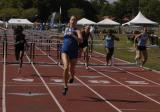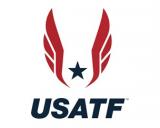Folders |
Seventy Years On From Bannister's First Sub-Four, Here Are Three Things You May Not KnowPublished by
By Philip Levinson for DyeStat Getty Images Beyond all the great and record-setting performances, track and field can boast having at least one poetically perfect achievement that transcended sports 70 years ago today. As we all know, Roger Bannister famously first broke the four-minute-mile barrier on May 6, 1954 at Oxford University's Iffley Road track. He became the first man to run a mile, four quarter-mile laps, averaging under 60 seconds per lap with his world record 3:59.4 mile. Norman Potter’s historic photo of Bannister breaking the tape as he collapsed across the line is cemented as one of the most iconic of the 20th century (and one of Life’s 100 Photographs That Changed The World). On this 70th anniversary, as we read the well-deserved tributes to the late Sir Roger Bannister and his milestone achievement, we are reminded of all the legendary details of the event. As World Athletics wrote, “The story of that race has been told so many times…that virtually every sports fan in the world must know the tale of the meticulous training and planning of Bannister and his two collaborators, Chris Brasher and Chris Chataway; of the athletes' anxious wait for the wind to drop; of the perfect, and controversial, pace making that made the record 'on', and of Norris McWhirter's famous announcement, ending as uproar drowned his words, ‘Result of the one mile, three minutes....’” Yes, most of us know all the legendary details, but there are some realities of this renowned achievement that are misunderstood or not nearly as well known. Here are three facts you may not know about Bannister’s first sub-four-minute mile: 1. A Rare False Start: With all the tension and anticipation about the record-breaking attempt, the famous mile race featured a rare middle-distance race false start by Chris Brasher, who was to assume critical pace-setting duties for the first half of the race. This was to the great consternation of Bannister, who was particularly frustrated at the delay after watching the wind – that had caused him to consider suspending his record attempt – temporarily die down just prior to the 6:10 pm start time.
We can wonder what might have happened if today’s World Athletics rules had been in effect at this fabled AAA vs. Oxford meet if it resulted in Brasher’s disqualification. Unlike runner Ethan Gregg, who was controversially disqualified in the 2023 NCAA Division III 5,000-meter final for his odd false start, Brasher was not subject to today’s no-exception policy. Fortunately, he remained in the race and then paced Bannister to history. 2. The Overstated Psychological Effect of Bannister’s Mile: Business, sports and psychology leaders have long pointed to the 4-minute mile as being primarily a mental barrier. Exemplified by this Harvard Business Review article, these experts argue that the four-minute barrier that had “stood for decades” was finally broken by Bannister in 1954, leading to “(other runners seeing) it could be done, and they did it, too.” This conventional wisdom points to Australian rival John Landy breaking the barrier and Bannister’s world record just 46 days later, and also cites all the runners that broke the barrier in the subsequent years. This is proof, they say, that Bannister’s race destroyed a psychological barrier, opening the floodgates for others. But this conventional wisdom is simplistic and arguably just plain wrong. Within 12 months of Bannister’s first sub-4, Landy was still the only runner to break four minutes. Then, three runners broke the barrier later in 1955, and five runners in the Olympic year of 1956. But The Science of Running points to different effects surrounding mile record progression involving stagnation and progression, which include the deleterious effect and delayed after-effects of World War 2. Their article outlines very similar stagnation-and-progression patterns with the 800 meters, 5,000 and 10,000 record-setting at that time. Also, what about other notable barriers that were broken that did not lead to floodgates opening? Let’s look at the high-school runners who broke four minutes. Three Americans broke the barrier in each of three years: Jim Ryun first going sub-4 in 1965, Tim Danielson in 1966, and Marty Liquori in 1967. What happened next? It was another 33-plus years before high-schooler Alan Webb broke four minutes in 2001, despite all the improvements in shoes and track surfaces, contrary to this mental barrier theory. 3. Bannister’s Inspirational Impact on Nike Founder Phil Knight: In May 1954, 16-year-old Phil Knight was a student athlete at Cleveland High in Portland and remembers his basketball coach incredulously discussing Bannister’s breakthrough mile.
“My father asked me if I would like to go to Vancouver to see the British Empire Games,” Knight said. “It was a gift from a busy, somewhat distant father to a dutiful, shy son. My father thought that would be the ultimate present for me, and he was right.” What was the effect of watching this race on the impressionable Knight? “That moment really bestowed a love for track and field,” he said. “It intensified it enormously. And what would my life be if that hadn’t happened? It was probably the best bonding experience that I’d had with my father in my whole life. So, it really had a significant role to play for me personally.” After that, with his father’s help, Knight was eventually invited to run at Oregon for Bill Bowerman, with whom he would eventually partner in launching Nike in 1964, 10 years after Bannister’s barrier-breaking achievement. Today, with Nike and Knight as two of the most powerful forces in sports – as well as track – we can point to this influence as yet another legacy aspect of Bannister and his achievements seven decades ago. Today, as we enter this exciting Olympic year, we can only guess at what the next iconic, front-page track achievement might be. In marking the occasion of Roger Bannister’s transcendent milestone, we stop and pay tribute to this event 70 years ago today that inspired the world. ---------------------------- Philip Levinson, who first read Bannister’s book The Four-Minute Mile in middle school, has published articles in TechCrunch, Business Insider, InformationWeek, TheNextWeb and Huffington Post. His last running article on Bill Dellinger was published by DyeStat here. More news |







